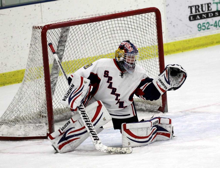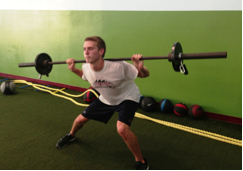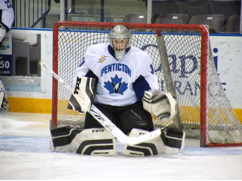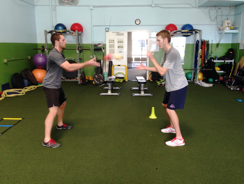Today’s article is a guest post from Chris Phillips, an Athletic Trainer and Strength and Conditioning Coach that runs a facility called Compete Sports Performance and Rehab in Southern California. Before opening Compete, Chris spent 8 years working in the NHL. It’s always great to get someone’s perspective that has worked at the highest levels, and is actively involved in training youth players. Enjoy today’s post and please post any comments you have below!
Off-Ice Training for Goalies
Off ice training plays a vital role in the development of hockey players. USA Hockey follows the Long Term Athletic Development principles as the basis of their program. These principles will assist in creating a more consistent training regimen. Today’s training programs should not be based on how hard the program is, but rather on specific goals and progressions.

Now that we covered some of the basics, here’s where it gets tricky. Should a goalie train like a skater? They both play the same game, so can we train them the same off the ice? Let’s look at the movements each player will go through during a game. A forward predominantly skates forwards, weaving and turning as they skate up the ice. A defenseman will skate backwards more than the forwards during a game. Both will utilize a crossover step while turning as well. There is one main component that is similar with skaters, they mainly skate north and south in a linear pattern.
Now let’s look at how a goalie moves. Their movement is more lateral in fashion, moving from post to post, not to mention dropping into a butterfly and getting back up on their skates quickly. It’s pretty obvious that the demands on a goalie are pretty different than a skater during a game. So if the demands are different, shouldn’t the training program be different? That’s not to say that there will not be a lot of crossover in the training program, but that there are certain aspects that need to be addressed. This isn’t always as easy as it sounds. Many teams train together and it can be difficult for the Strength Coach to modify the program for the goalies, but it should be noted and modified as much as possible.

Now that we have deciphered that the demands on a goalie are different than a skater and that their programs should also be different, what should be the focus of the program? The program needs keep in mind the age and level of the athlete. Exercises that are good for one goalie may be too complex for another. Always begin simple, then as the athlete masters the exercise, make it more difficult. Adding resistance, placing the athlete on an unstable surface or making the movement more complex are all good examples of how to make the training more difficult.

There is an unlimited amount of exercises that can be used with goalies that will improve performance on the ice.
Using the principles previously mentioned, here are some key exercises that can be implemented into your goalie training program:

The way you train off the ice directly affects the way you perform on the ice. Take a step by step approach with long term athletic development in mind. Have goals in mind with proper technique and progression as the basis of your program to maximize performance and limit injuries.
Chris Phillips is a certified Athletic Trainer and Strength and Conditioning Specialist with over 20 years experience in professional sports. Chris spent 8 years in the NHL with the Mighty Ducks of Anaheim and the Washington Capitals. He was a member of the 2003 Mighty Ducks Stanley Cup Finalists and now owns and operates Compete Sports Performance and Rehab in Orange County, California. Chris can be contacted via email at chris@competeperformance.com or through their website at www.competesportsperformance.com.
To your success,
Kevin Neeld
HockeyTransformation.com
OptimizingMovement.com
UltimateHockeyTraining.com
Please enter your first name and email below to sign up for my FREE Athletic Development and Hockey Training Newsletter!
“Kevin Neeld is one of the top 5-6 strength and conditioning coaches in the ice hockey world.”
– Mike Boyle, Head S&C Coach, US Women’s Olympic Team
“…if you want to be the best, Kevin is the one you have to train with”
– Brijesh Patel, Head S&C Coach, Quinnipiac University